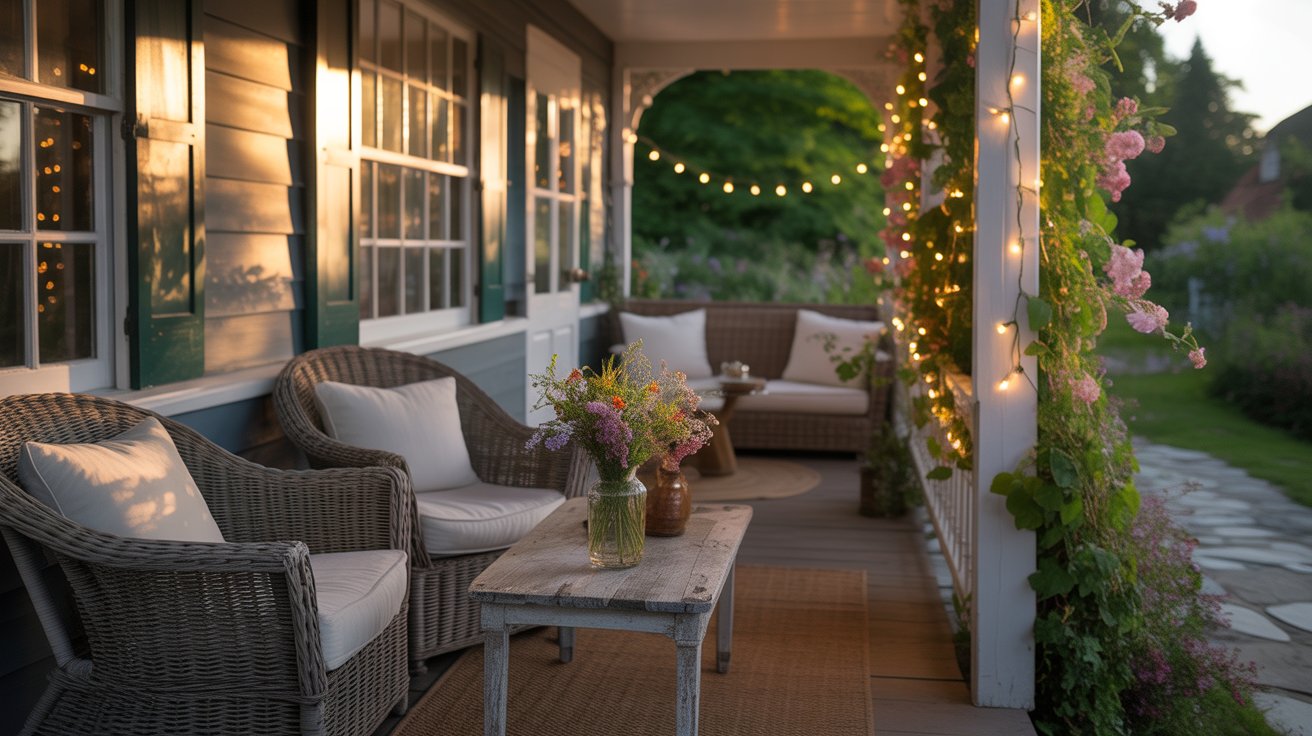There’s nothing quite like stepping outside into a calm, cozy corner of your home — a place that feels private, comfortable, and built for relaxation. Whether you’re working with a wide Southern porch, a narrow London balcony, or a small urban deck, this guide — Outdoor Oasis: Creating Inviting Porch and Patio Retreats — will walk you through durable fabrics, weather-proof lighting, climate-smart planting, furniture choices, and maintenance so your outdoor space stays beautiful season after season.
This post is written for readers in the United States and the United Kingdom and includes practical, climate-aware advice, interactive prompts, and trusted sources so you can dig deeper if you want. Let’s get started.
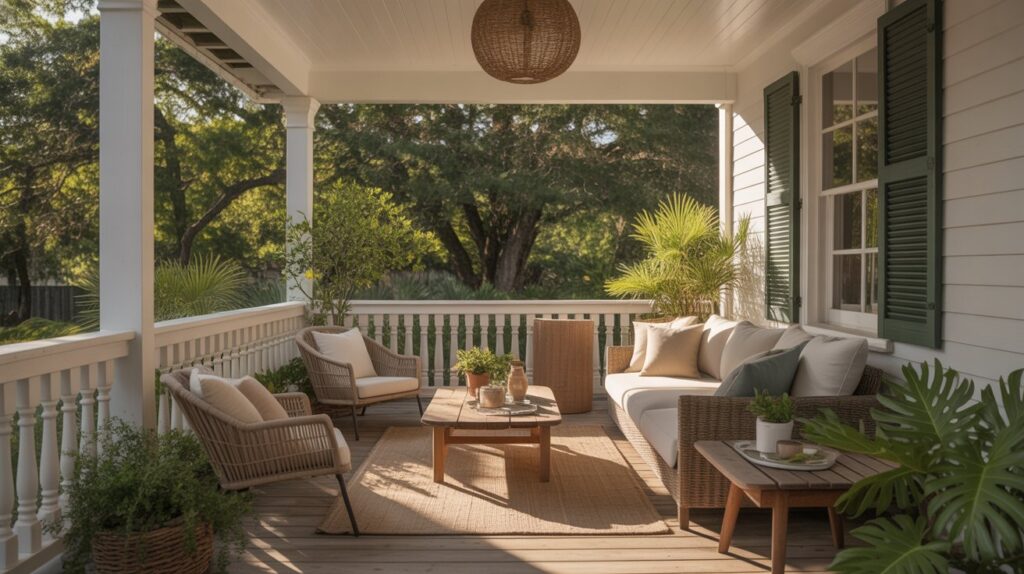
Why an outdoor oasis matters (and what “inviting” really means)
An inviting porch or patio extends your living space, encourages time outdoors, and can seriously boost your day-to-day wellbeing. An ideal outdoor oasis balances four things: comfort, durability, weather-resilience, and personality. The trick is choosing materials and plants that match your local climate and lifestyle, then layering lighting and textiles to create atmosphere.
Quick interactive question: what’s your biggest outdoor goal this season?
- More shade
- Planting an easy care garden
- A cozy evening hangout
- A dining/party spot
Tell us in the comments and we’ll reply with a short tailored tip.
1. Start with a site map: sun, wind, and sightlines
Before you buy anything, spend 48 hours watching the space. Sketch a simple site map noting:
- Where strong sun falls (morning vs. afternoon).
- Wind direction and gustiness (important for lightweight umbrellas, lanterns, and potted plants).
- Sightlines you want to enjoy (garden, street, skyline) and eyesores you may want to screen.
This step prevents impulse purchases that don’t work in place. Measure the usable area and draw zones for dining, lounging, and planting so you can buy furniture that truly fits.
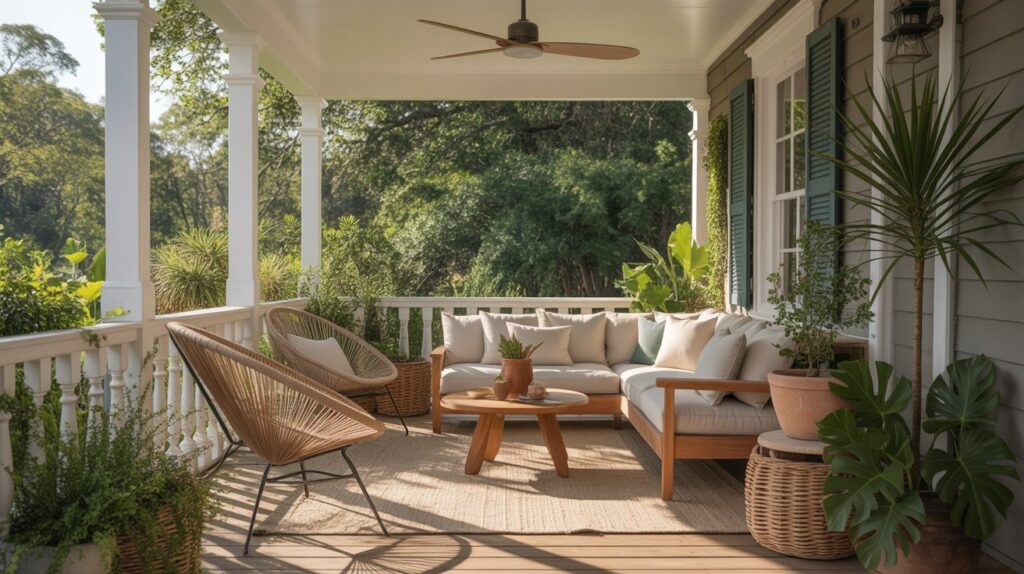
2. Pick fabrics that survive sun, rain and pets
Outdoor textiles are not all created equal. Look for performance fabrics that resist UV fading, mildew, and stains — especially for cushions and umbrellas.
- Solution-dyed acrylics (e.g., Sunbrella) are widely used for outdoor upholstery: they resist fading and are easy to clean with mild soap and water. Follow the manufacturer’s cleaning guidelines to keep fabrics looking fresh. (Sunbrella)
- Olefin (polypropylene) rugs work well outdoors: they drain and dry quickly, and modern weaves look surprisingly high-end.
- Quick-dry cushion cores and ventilated seat pads prevent water from sitting inside cushions after a shower.
Style tip: choose one durable base fabric for large pieces (sofa/bench/umbrella) and introduce color or pattern with changeable accent cushions and rugs. That way you can refresh the look with minimal expense.
3. Weather-proof lighting: safety, atmosphere and efficiency
Lighting turns a daytime patio into a night-time retreat. Aim for layered lighting: ambient (string lights), task (step lights, reading lamps), and accent (uplights for specimen plants).
- IP (Ingress Protection) ratings indicate how well a fixture resists dust and water — for most outdoor fixtures you’ll want at least IP44 for splash protection or IP65 for exposed, wetter locations. The IP system is defined by international standards (IEC 60529). Always check a product’s IP rating before using it outdoors. (Wikipedia)
- Safety first (UK guidance): Electrical charities and regulators recommend using outdoor-rated fixtures and connecting through RCD-protected circuits (and a qualified electrician for hard-wired fittings). (Electrical Safety First)
- Energy efficiency: LEDs use far less energy and last longer; choose warm-white LEDs (2700–3000K) for a cozy glow. The U.S. Department of Energy offers practical guidance on LED outdoor lighting and using fixtures with good optical control to reduce glare and light pollution. (The Department of Energy’s Energy.gov)
Practical idea: hang outdoor-rated LED string lights under an eave (protected) or along a pergola. For exposed posts, choose sealed IP65-rated fixtures.
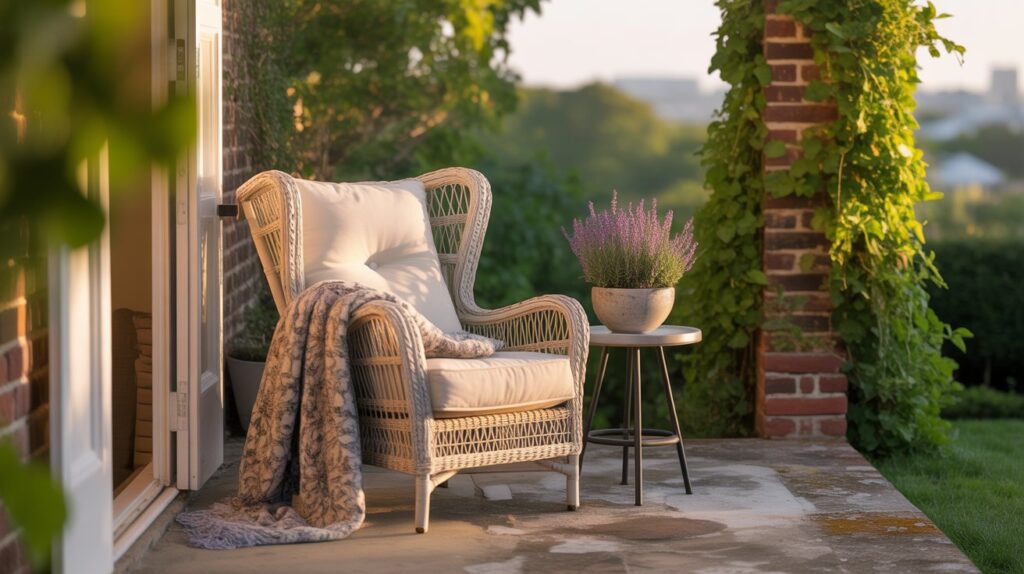
4. Choose climate-smart plants (use the right authoritative tools)
What grows well on a sun-soaked Southern porch won’t always thrive on a cool, windy balcony in northern England. Use hardiness and exposure maps to choose plants that’ll thrive where you live:
- In the U.S., the USDA Plant Hardiness Zone Map helps you see which perennials survive winter minimums in your area and plan accordingly. (Check your zone and choose plants rated for it.) (USDA Plant Hardiness Zone Map)
- In the UK, the Royal Horticultural Society (RHS) has excellent advice on balcony and container planting, with recommendations for sun, shade, and exposure, plus guidance on watering and soil for pots. Their container-growing guidance is especially helpful for small patios and balconies. (RHS)
Climate-friendly planting ideas:
- Hot & dry (Mediterranean/California): Lavender, rosemary, sedums and ornamental grasses. Use terracotta or porous pots for good drainage.
- Humid & warm (Southeast US / milder UK summers): Hibiscus (in pots), begonias, hardy ferns in sheltered spots.
- Cool/variable (northern US, UK): Box hedging, heathers, hellebores, potted fruit trees with winter protection.
- Coastal/salty air: Salt-tolerant plants like sea thrift, yucca, and rosemary in sturdy heavy pots.
Tip: group containers by water needs and use larger pots for big plants (they hold moisture better). For a wildlife boost, include a few pollinator-friendly plants — RHS lists top patio plants that attract bees and beneficial insects. (RHS)
5. Furniture: choose materials that match your climate and lifestyle
Your furniture should be comfortable, proportionate and built to handle local weather.
Good material choices:
- Teak and dense hardwoods: naturally weather-resistant and age to a silvery patina; oil or reseal occasionally for longevity.
- Powder-coated aluminium: rust-proof and lightweight — great for coastal or humid areas.
- Synthetic rattan / resin wicker: looks like rattan but stands up far better to wet weather.
- Polywood or recycled plastic lumber: low maintenance and durable for long seasons outdoors.
Practical picks:
- Choose seating with removable cushion covers (for washing or storage).
- Invest in one larger, fixed seating piece (a sturdy bench or sofa) and add lightweight chairs you can move when wind picks up.
- Consider multi-function pieces (storage benches, ottomans with storage) to hide cushions & garden tools quickly.
Budget tip: if you want the teak look but not the price tag, store-brand teak finishes and high-quality composite timbers give similar style with lower maintenance.
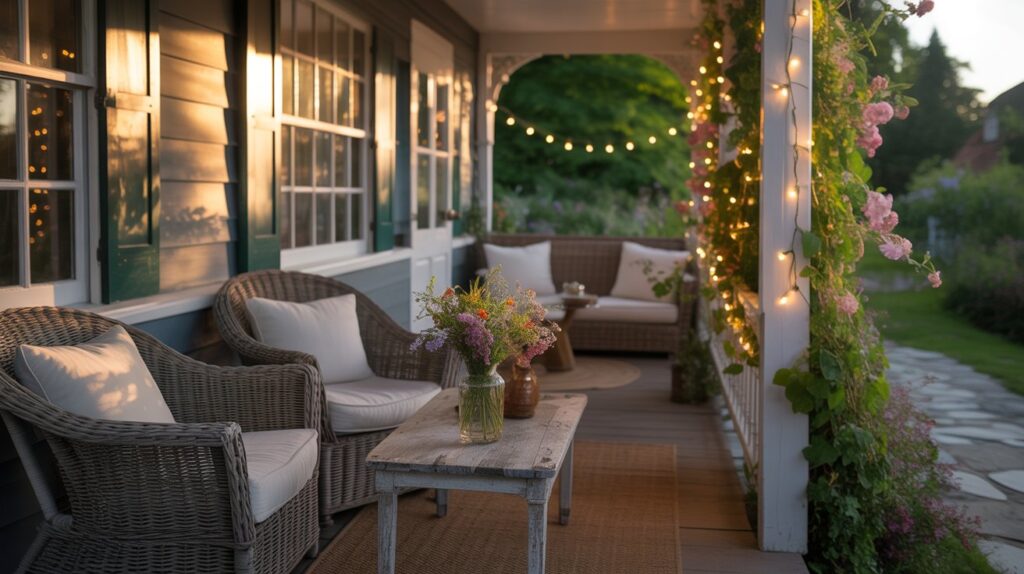
6. Zoning: create separate “mini-rooms” that flow
Even small decks can feel generous if you define functional zones:
- Dining nook: foldable or extendable table and stackable chairs save space.
- Lounge: a weatherproof sofa, low coffee table, and an outdoor rug to anchor the area.
- Green nook / reading corner: a comfy chair with plant shelves and a small side table.
- Prep & drink station: a compact trolley that doubles as a bar and storage.
Use rugs, planters, pergolas, or screens to separate zones without building walls. Visual division signals purpose and makes small spaces feel purposeful.
7. Weather-proof accessories that add personality
Accessories are where style shows — but pick items built for outdoors:
- Outdoor rugs: polypropylene or recycled fiber rugs are washable and drainable.
- Cushions & throws: choose water-repellent covers; keep spares inside during storms.
- Lanterns and hurricane lamps: battery or USB LED versions are safe in wind.
- Fire element: a properly sited gas fire table or designated fire pit creates ambience — always follow local codes.
- Planter grouping: mix heights and pot textures for visual interest.
Pro tip: commit to a palette of two main colors + a neutral to keep the space cohesive and low-maintenance.
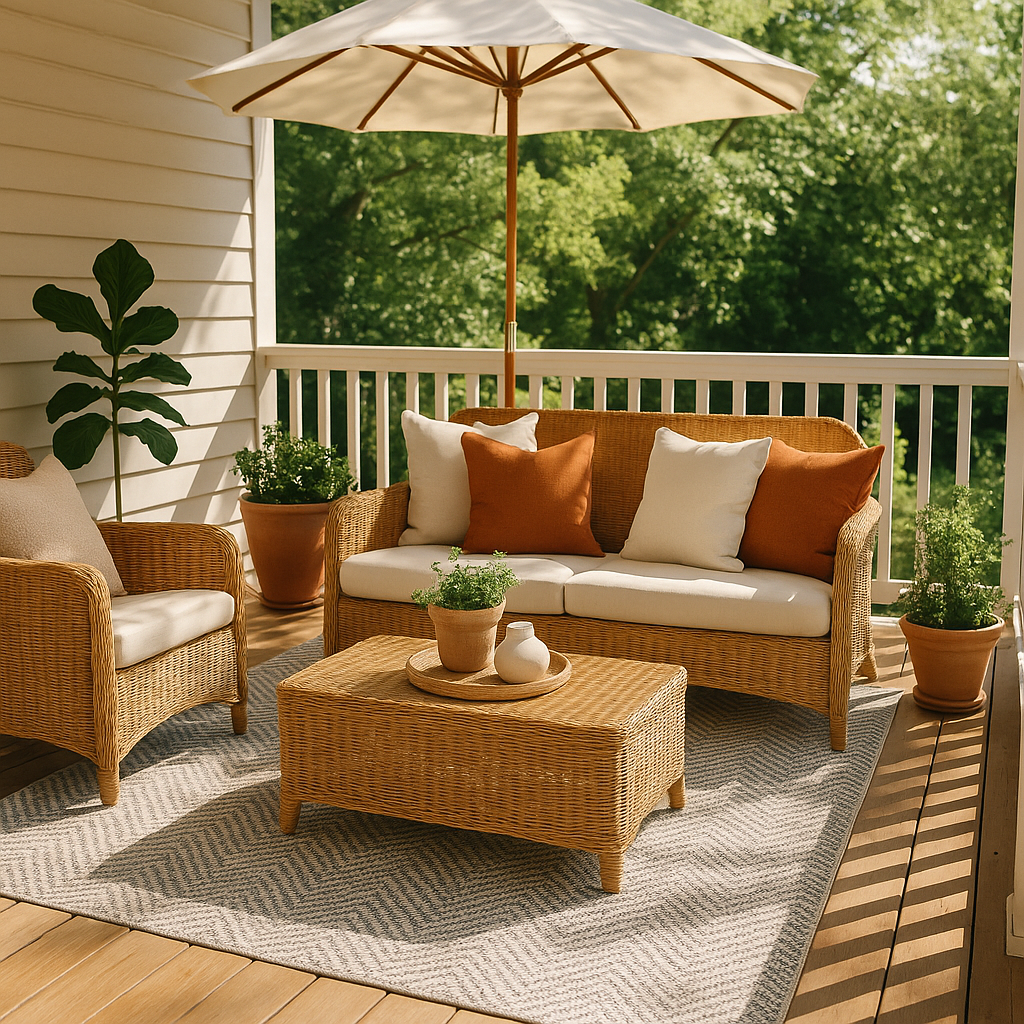
8. Maintenance routine: small effort, big payoff
A quick maintenance routine keeps your outdoor oasis inviting:
- Rinse furniture and rugs occasionally to remove pollen and dust. Better Homes & Gardens provides testing-based tips on protecting furniture and covers for different climates. (Better Homes & Gardens)
- Clean outdoor fabrics per maker instructions (Sunbrella and similar brands publish step-by-step cleaning guides). Regular gentle cleaning prevents stains from setting. (Sunbrella)
- At season change: store vulnerable cushions, sweep leaves, and top up potting mix. Move mobile pots into shelter for hard freeze or severe storms.
Season checklist (short):
- Spring: deep clean, check seals, repot if needed.
- Summer: monitor irrigation and pests.
- Autumn: clear fallen leaves, protect tender plants.
- Winter: store electronics/cushions, secure lightweight furniture.
9. Small-space hacks for balconies and narrow porches
Tight on space? Try these space-stretching tricks:
- Use vertical planters and wall trellises to add greenery without losing floor space.
- Install a fold-down table for meals that folds back to a slim profile when not in use.
- Choose stackable chairs or bench seating that tucks under tables.
- Opt for slimline planters and narrow console tables to keep traffic paths clear.
RHS has helpful advice for balcony planting and how to create shelter from wind to establish a microclimate — invaluable for high-rise or exposed urban balconies. (RHS)
10. Sustainable choices that last
Making sustainable choices often saves money long term:
- Buy high-quality materials that can be repaired rather than replaced.
- Choose native or drought-tolerant plants to reduce watering needs and support local wildlife.
- Reuse items where possible (pallets turned into seating, reclaimed pavers for fire pits).
- Use LED lighting and timers/sensors to cut electricity use and avoid unnecessary light waste; the Department of Energy highlights the energy and longevity benefits of LED outdoor lighting. (The Department of Energy’s Energy.gov)
11. Design checklist: build your oasis in 7 days (starter plan)
Day 1: Map the space (sun/wind/sightlines).
Day 2: Buy a durable seating piece and an anchoring rug.
Day 3: Choose an umbrella or shade solution for hottest sun.
Day 4: Add lighting (string lights + one task light).
Day 5: Place containers and plants — group by water needs.
Day 6: Add textiles, planters, and a fire or heater element if desired.
Day 7: Final styling and photo — share it!
Share your before/after pictures with #OutdoorOasisRetreats — we’ll feature the best transformations.
Helpful resources (authoritative links)
- USDA Plant Hardiness Zone Map — use this to choose perennial plants that match your minimum winter temperature. (USDA Plant Hardiness Zone Map)
- Royal Horticultural Society — practical advice for balconies, containers, and plant selection in the UK climate. (RHS)
- Sunbrella fabric care — official cleaning and care guidance for a leading performance fabric brand. (Sunbrella)
- Electrical Safety First (UK) — guidance on IP ratings and electrical safety for outdoor lighting. (Electrical Safety First)
- U.S. Department of Energy — guidance on LED outdoor lighting and energy savings. (The Department of Energy’s Energy.gov)
FAQs
Q: How do I choose plants for a very windy balcony?
Choose low, sheltered plants with flexible stems and plant windbreaks (tall grasses or trellised climbers) to create a microclimate. Use heavy pots to prevent tipping.
Q: Can I leave cushions out during rain?
Short answer: no. Even water-resistant cushions can trap moisture. Use quick-dry cores and water-resistant covers, and store cushions during long wet periods.
Q: What IP rating do I need for exposed lights?
For fixtures exposed to the elements (rain splashes or jets), choose IP65 or higher. For more sheltered spots, IP44 may suffice — but always follow manufacturer guidance and local electrical codes. (Wikipedia, Electrical Safety First)
Final thoughts
Creating an Outdoor Oasis: Creating Inviting Porch and Patio Retreats is about marrying style with practicality. Start with the climate and site, choose durable fabrics and fixtures, pick plants suited to your growing zone, and layer lighting and textiles for a comfortable mood. With a few well-chosen, weather-proof investments and a bit of seasonal care, your porch or patio can become an everyday retreat that feels like a mini-vacation.
Ready to plan your outdoor refresh? Use the 7-day checklist above, or post your space with #OutdoorOasisRetreats and we’ll give quick styling feedback.
Disclaimer: This post offers general design and care guidance. For electrical installations or structural changes, consult a qualified professional. Plant hardiness and local regulations vary — use the provided resources to confirm choices for your exact location. All images used in this article are royalty‑free or licensed for commercial use and are provided here for illustrative purposes.
